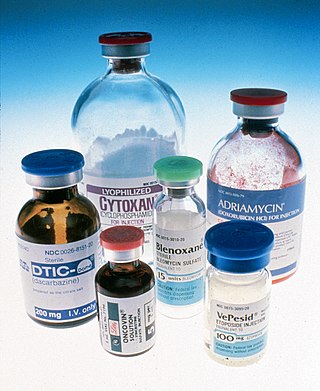
Vincristine, also known as leurocristine and marketed under the brand name Oncovin among others, is a chemotherapy medication used to treat a number of types of cancer. This includes acute lymphocytic leukemia, acute myeloid leukemia, Hodgkin's disease, neuroblastoma, and small cell lung cancer among others. It is given intravenously.

The era of cancer chemotherapy began in the 1940s with the first use of nitrogen mustards and folic acid antagonist drugs. The targeted therapy revolution has arrived, but many of the principles and limitations of chemotherapy discovered by the early researchers still apply.

Vinblastine (VBL), sold under the brand name Velban among others, is a chemotherapy medication, typically used with other medications, to treat a number of types of cancer. This includes Hodgkin's lymphoma, non-small cell lung cancer, bladder cancer, brain cancer, melanoma, and testicular cancer. It is given by injection into a vein.

Melphalan, sold under the brand name Alkeran among others, is a chemotherapy medication used to treat multiple myeloma, ovarian cancer, melanoma, and AL amyloidosis. It is taken by mouth or by injection into a vein.
MOPP is a combination chemotherapy regimen used to treat Hodgkin lymphoma. The acronym is derived from the component drugs of the regimen:

Dactinomycin, also known as actinomycin D, is a chemotherapy medication used to treat a number of types of cancer. This includes Wilms tumor, rhabdomyosarcoma, Ewing's sarcoma, trophoblastic neoplasm, testicular cancer, and certain types of ovarian cancer. It is given by injection into a vein.

Dacarbazine (DTIC), also known as imidazole carboxamide, is a chemotherapy medication used in the treatment of melanoma and Hodgkin's lymphoma. For Hodgkin's it is often used together with vinblastine, bleomycin, and doxorubicin. It is given by injection into a vein.
CHOP is the acronym for a chemotherapy regimen used in the treatment of non-Hodgkin lymphoma. CHOP consists of:

Chlorambucil, sold under the brand name Leukeran among others, is a chemotherapy medication used to treat chronic lymphocytic leukemia (CLL), Hodgkin lymphoma, and non-Hodgkin lymphoma. For CLL it is a preferred treatment. It is given by mouth.
Stanford V, is a chemotherapy regimen intended as a first-line treatment for Hodgkin lymphoma. The regimen was developed in 1988, with the objective of maintaining a high remission rate while reducing the incidence of acute and long term toxicity, pulmonary damage, and sterility observed in alternative treatment regimens such as ABVD. The chemical agents used are:

Ifosfamide (IFO), sold under the brand name Ifex among others, is a chemotherapy medication used to treat a number of types of cancer. This includes testicular cancer, soft tissue sarcoma, osteosarcoma, bladder cancer, small cell lung cancer, cervical cancer, and ovarian cancer. It is administered by injection into a vein.

Lomustine (INN); abbreviated as CCNU; original brand name CeeNU, now marketed as Gleostine) is an alkylating nitrosourea compound used in chemotherapy. It is closely related to semustine and is in the same family as streptozotocin. It is a highly lipid-soluble drug, thus it crosses the blood–brain barrier. This property makes it ideal for treating brain tumors, which is its primary use, although it is also used to treat Hodgkin lymphoma as a second-line option. Lomustine has a long time to nadir.
ABVD is a chemotherapy regimen used in the first-line treatment of Hodgkin lymphoma, replacing the older MOPP protocol. It consists of concurrent treatment with the chemotherapy drugs:

Carmustine, sold under the brand name BiCNU among others, is a medication used mainly for chemotherapy. It is a nitrogen mustard β-chloro-nitrosourea compound used as an alkylating agent.

Pegaspargase, sold under the brand name Oncaspar, is a medication used in the treatment of acute lymphoblastic leukemia (ALL). Often it is used together with anthracycline, vincristine, and corticosteroids. Pegaspargase can be administered either via an intravenous infusion or a intramuscular injection.
An alkylating antineoplastic agent is an alkylating agent used in cancer treatment that attaches an alkyl group (CnH2n+1) to DNA.

Bendamustine, sold under the brand name Treanda among others, is a chemotherapy medication used in the treatment of chronic lymphocytic leukemia (CLL), multiple myeloma, and non-Hodgkin's lymphoma. It is given by injection into a vein.
Emil J. Freireich was an American hematologist, oncologist, and cancer biologist. He was recognized as a pioneer in the treatment of cancer and use of chemotherapy and is often known as the father of modern leukemia therapy.
VAMP regimen or VAMP chemotherapy is a four-drug combination chemotherapy regimen, used today in the treatment of Hodgkin lymphoma. It was one of the earliest combination chemotherapy regimens, originally developed as a treatment for childhood leukemia by a group of researchers at the National Cancer Institute led by Emil Frei and Emil Freireich. The first clinical trial of VAMP began in 1961. Because it was the first time that four chemotherapeutic agents were used at once, the trial was highly controversial at its time. Although new combination chemotherapy regimens have replaced the use of VAMP in the treatment of childhood leukemia, VAMP is considered an important precursor to modern treatments, confirming the effectiveness of combination chemotherapy and leading to the use of combination chemotherapy regimens to treat other types of cancer.

Anaplastic oligodendroglioma is a neuroepithelial tumor which is believed to originate from oligodendrocytes, a cell type of the glia. In the World Health Organization (WHO) classification of brain tumors, anaplastic oligodendrogliomas are classified as grade III. In the course of the disease, they can degenerate into WHO grade IV glioblastoma. The vast majority of oligodendrogliomas occur sporadically, without a confirmed cause and without inheritance within a family.















